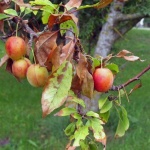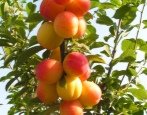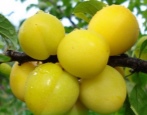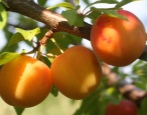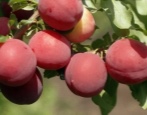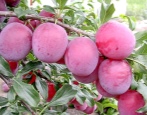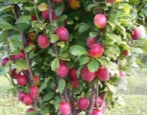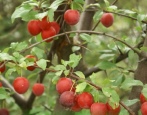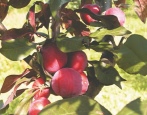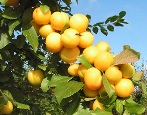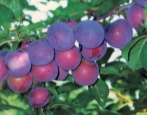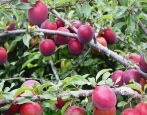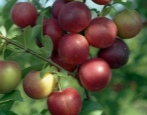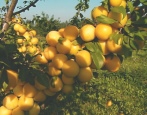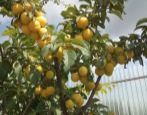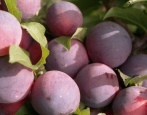
- Appeared when crossing: Elite form 18/1 (Ussuri plum and cherry-plum) х Fast-growing
- Growth type: medium-sized
- Ripening period: mid-early
- Self-fertility: self-infertile
- Fruit size: medium size
- Yield: fruitful
- Appointment: for canning, for fresh consumption
- Fruit weight, g: 20-22
- Fruit shape: round-ovoid
- Fruit color: yellow
Variety Vetraz appeared when crossing Elite form 18/1 and Fast-growing. It can be grown both for fresh consumption and for canning.
Description of the variety
Cherry plum Vetraz is a medium layer. Its height can be up to 5 meters. The crown of the trees is slightly raised, flat, of medium density.
Fruit characteristics
Ripe fruits are medium in size. Each of them weighs 20-22 grams on average. Their shape is round-ovoid. The color is yellow. The skin on the berries has a light waxy bloom.
The flesh of the fruit is juicy and tender, its color is yellow-green. The bone is of medium size, the separation of the bone from the pulp is poor.
Taste qualities
Ripe fruit will taste sweet and sour. The tasting score was 4.4 points.
Ripening and fruiting
Trees will bear fruit for 2-3 years after planting. The variety is considered medium early. The fruiting period is in early August.
Yield
Cherry plum Vetraz has an average yield. About 20 tons of fruits can be harvested from one hectare.
Growing and care
It is permissible to plant cherry plum both in autumn and spring. For this culture, it is necessary to select the most illuminated areas, protected from the winds. Vegetation prefers neutral soils, so the acidified soil is pre-treated with dolomite flour or lime.
In the spring, before planting, the bulk of the land is dug up. The dimensions of the pit should be approximately 60x60x60 centimeters. Humus and wood ash are placed on the bottom. It is also recommended to add fertilizers there, which contain phosphorus and potassium.
A small mound is formed in the central part of the resulting holes. The seedlings are carefully lowered into the holes. Their roots are gradually spread. A peg is driven in next to it. Its height must be at least 1 meter. The roots of vegetation are covered with earth. After that, young seedlings begin to be tied to pegs. The soil around is lightly tamped, and then watered abundantly. One such plant will have about 15 liters of water.
After planting, cherry plum will require timely watering. The crop should be watered especially abundantly in the first year after planting. However, excess moisture should be avoided. Further, the number of procedures is gradually reduced.
Weeding and mulching are essential. If vegetation is grown in arid regions, then there should always be a layer of mulch around it. In other cases, mulching is performed only once every 1-2 years. It is best to sprinkle peat or humus around. The layer thickness should be at least 7-10 centimeters. Loosening and weeding the soil around the trees should be 4-5 times per season.
Feeding is also of great importance. In this case, the first 2-3 years after planting, the culture can not be fertilized. When it already begins to bear fruit, phosphate agents, manure, ammonium nitrate should be used. It is recommended to introduce the listed substances in the fall in the process of digging the soil.
After flowering, trees can be fed with fertilizers that contain potassium and nitrogen. You can also use mullein or bird droppings, they are pre-bred in heated water.
Remember that all diseased and damaged parts on the plants must be removed and burned immediately. Also, Bordeaux liquid should be used as a prophylaxis. Processing is carried out three times per season.
Cherry plum will need pruning and shaping.In the first two years after planting in the ground, it is worth removing all knots. In this case, the number of skeletal branches should be no more than 3-4 pieces. The undergrowth that forms around the trunk is harvested annually.
It is better to pinch the tops of young plants. Moreover, this procedure must be carried out in the summer season. 3-4 years after planting, the central conductor is cut out. This procedure will allow you to form a bowl-shaped crown.
In the spring, crown thinning is performed, during which dry branches are removed. It is also worth removing shoots that grow at a distance of less than 20 cm from each other.
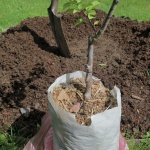
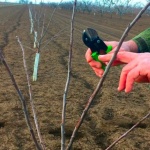
Disease and pest resistance
Cherry plum Vetraz is considered resistant to diseases and pests. And yet, sometimes it can be affected by brown spot, coccomycosis, moniliosis, perforated spot. To combat such diseases, you must first remove and burn all damaged branches on the trees. After that, they are treated with a solution of Bordeaux liquid. Moreover, such procedures should be repeated several times in order to achieve a positive result.
Often, the culture is also affected by harmful insects: fruit mite, plum aphid, sawfly. To cure vegetation and destroy all harmful insects, you can use ready-made preparations (Karbofos, Fufanon, Karate). Often, healthy trees are treated with safe biological agents as a preventive measure.
